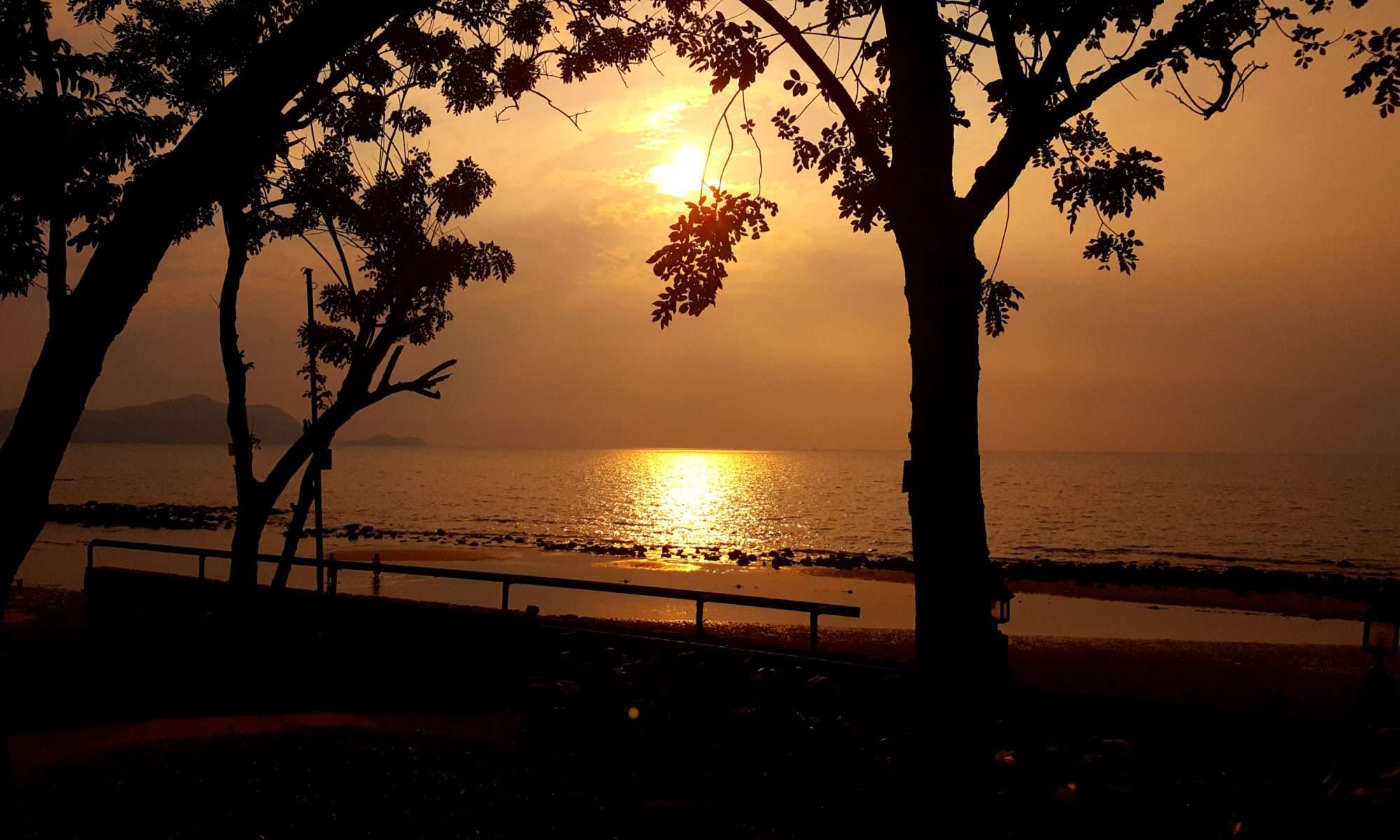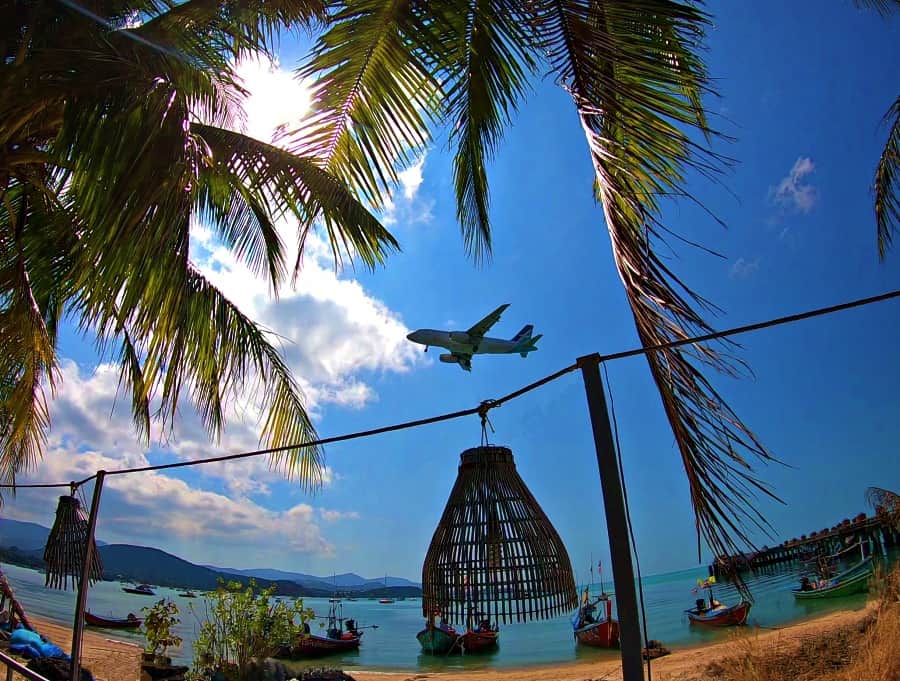
So, you are traveling to Thailand for a vacation or for business and you will arrive at Bangkok’s Suvarnabhumi International Airport. That was the easy part of the trip.
Now what? How do I get around? Do I take a taxi everywhere or do I rent a car? What other options are there in Thailand?
Well, this really depends on your tastes, budget, what you will be doing and how far you will be going. Are you going to several different cities? How many people are traveling with you? I think you get the picture. Let’s break down all the options that Thailand has to offer.
Options for medium to long distance transportation.
Flying in Thailand.
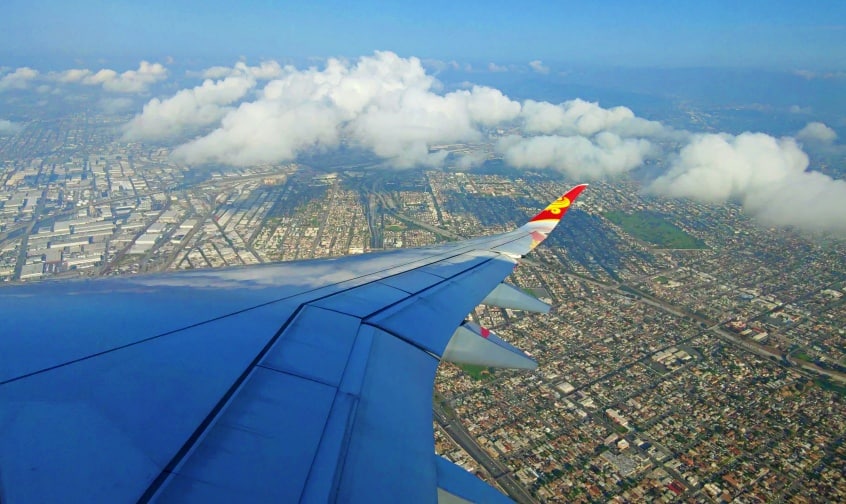
If you are wanting to get to the farthest cities from Bangkok, like Chiang Mai or Phuket, then flying is by far the quickest way to do so. Both of these cities take about an hour and ten minutes to fly to from Bangkok.
Closer cities like Pattaya are only an hour and a half drive on the expressway so there is no point in flying. In fact, because they make a stop, flying takes 4-5 hours and costs over $120.00 round trip to Pattaya.
Bangkok’s airports.
There are two airports in Bangkok, Suvarnabhumi International (BKK) and Don Mueang (DMK). Although both of these airports have domestic and international flights, Don Mueang is more domestic flight oriented with most of its international flights designated to Asian countries, India and one to Australia. On the other hand, Suvarnabhumi International will get you most anywhere in the world.
Domestic airlines.
The most popular domestic airlines at Don Mueang airport are; Air Asia, Thai Lion Air and Nok Air that can get you to over 25 cities throughout Thailand. Over at Suvarnabhumi airport these are; Bangkok Airways, Thai Airways and Thai Smile Airways with around 16 destinations in Thailand. Skyscanner is a pretty popular site that my wife uses for booking domestic flights in Thailand.
How much do they cost?
As far as pricing is concerned, these airlines are quite affordable with rates as low as $35 (low season) $65 (high season) for a round trip ticket. The reason for this is because there is so much competition.
But, there is one exception to this. Because Bangkok Airways is the only airline that flies to the Thai island of Samui, the average price is over $200 round trip. Check out my article for a cheaper way to get to Koh Samui.
Transferring between Bangkok’s Suvarnabhumi and Don Mueang airports.
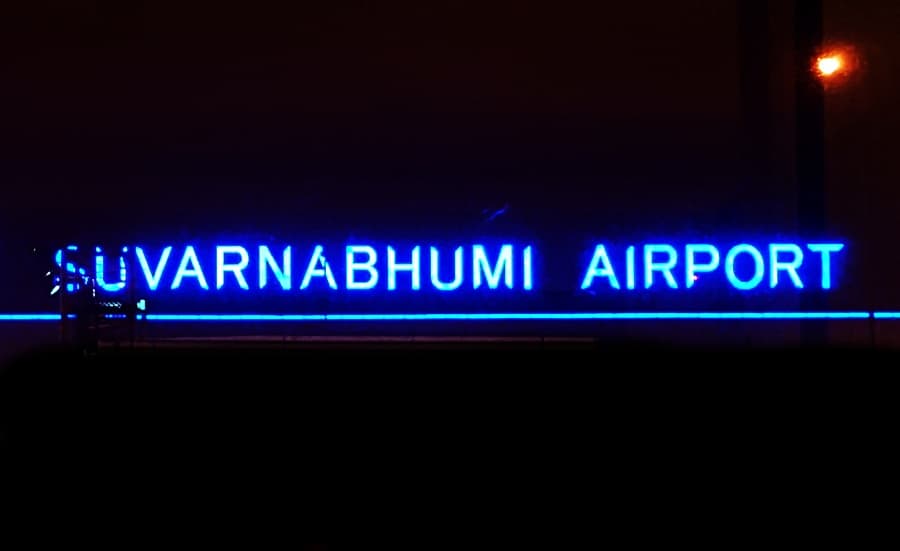
If you booked your domestic flight from Don Mueang airport and it leaves shortly after your arrival to Suvarnabhumi airport, you will need to transfer to Don Mueang airport.
Make sure you leave at least a 3-4 hour window between flights for exchanging money, getting baggage, travel time and then the security check at Don Mueang. Not to mention this gives you a break from the flying you just did.
Free shuttle bus.
Now, if you are on a strict budget, there is a free shuttle bus that runs from 5AM to midnight, which takes around an hour (or 2 if extreme traffic conditions) to get to Don Mueang airport. The free shuttle is outside door 3 on the 2nd floor of Suvarnabhumi airport and is first come first served. Don’t worry if it is full, a new shuttle will arrive every 15-30 minutes, depending on the time of day. Just show your airline boarding pass to get on the shuttle.
Using a taxi.
If budget isn’t a big deal, I recommend taking a metered taxi. It is usually a little faster (around 45 minutes) and only costs around 400-500 THB or around $15 for the taxi and toll charges. The taxi counters at Suvarnabhumi airport are located on level 1 (ground level) near entrances 3, 4, 7 and 8. Get your ticket from a queue machine and go outside to the lane number printed on your ticket.
Make sure you exchanged some money to Thai Baht for the taxi fare and the toll charges. The taxi driver will not pay the tolls and ask you to pay them back when you arrive. You must have the money ready as you approach the toll booths.
Check out my in depth article on using your money in Thailand.
Thailand’s Trains.
Thailand loves its trains and they are very popular with local Thai’s because they are budget friendly. Backpackers and the like are also more likely to take the trains for this same reason. If you are looking to save some money and aren’t worried about how much time it takes to get to your destination, this is for you.
Bangkok’s train station.
The State Railway of Thailand has 6 lines that can get you pretty much anywhere in Thailand and beyond. These include; Northern line, Southern line, Eastern line, Northeastern line, the Mae Klong and Historical lines. These lines are all linked via Hua Lamphong Railway Station in central Bangkok.
Hua Lamphong train stations Address: 191, Rong Mueang Rd, Khwaeng Rong Muang, Khet Pathum Wan, Krung Thep Maha Nakhon 10330, Thailand.
How much to take a train?
The cost for taking a train starts around 231 THB ($7.50) per seat for a 3rd class one way ticket to Chiang Mai. If you want a 1st class sleeper with air conditioning, you will pay around 1,653 THB ($54) to get to Chiang Mai.
12go asia is a good place to purchase your tickets as they know everything about Thailand’s trains. Or simply buy tickets at the station you are leaving from.
How much time on the train?
Lastly, let’s talk about time. Most of the longer distance destinations like Chiang Mai or Phuket will average 8-13 hours depending on the train, how many stops etc. etc. There is also the fact that almost all trains will travel overnight so the scenery is basically non-existent most of the trip.
The good news is, not only might you save money on transport, you will save one night of accommodations by sleeping on the overnight train. And the experience of taking a long journey on a train will give you some stories to tell back home.
Taking a Bus in Thailand.
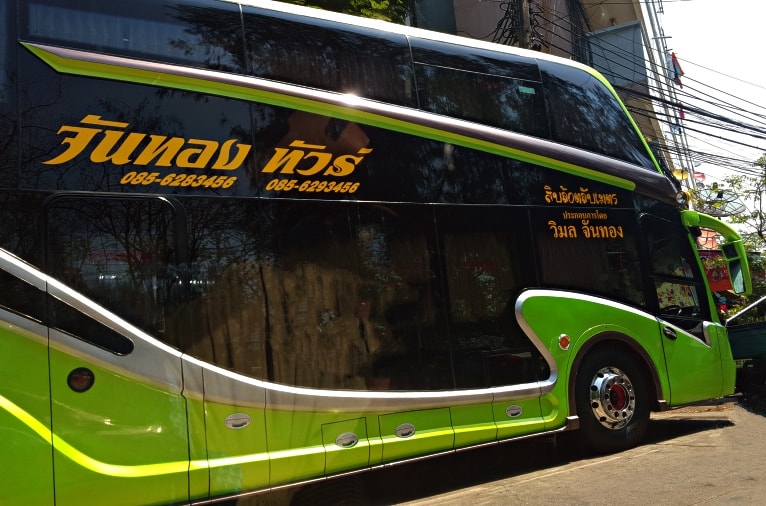
Like Thailand’s trains, buses are a very popular means of travel in Thailand. Long distance travel by bus can get you to just about any city in Thailand and even cities in neighboring countries like Myanmar, Cambodia, Laos and Malaysia.
Cost of taking the bus.
One of the benefits of traveling by bus is the low cost. Starting at $20-$32 each way, (say to Chiang Mai from Bangkok), depending on transportation companies and seasons. Some daily buses offer television, snacks, WiFi and overnight buses will have reclining seats and blankets.
How long do buses take?
As with the trains in Thailand, time is the negative if you need to get to your farther destinations quickly. Typically 10-12 hours to Chiang Mai or 12-14 to Phuket from Bangkok. But, unlike trains, there are a lot more running during the day so you can take in the scenery of the local countryside.
Getting tickets.
Getting bus tickets is quite simple. You can go to various bus stations or get them online. Again, 12go.asia is a good site for buses as well as trains.
These are the three main bus terminals in Bangkok with links.
Northern Terminal-Mo Chit.
Bangkok’s largest terminal serving north and northeastern Thailand like Chiang Mai, Chiang Rai and Isaan. Some privately owned bus companies here offer runs to Phuket and some to the Eastern Seaboard including Pattaya, Rayong, Koh Samet and Koh Chang.
Eastern Terminal-Ekkamai.
This terminal is the smallest and services the east coast including Rayong, Suratthani and Pattaya among others on the Eastern Seaboard.
Southern Terminal-Sai Tai Mai.
Buses here serve the south, such as Hua Hin, Koh Samui, Krabi and Phuket.
Bus Classes
Generally there are two classes of private buses in Thailand: Express and VIP.
Express buses may take a little longer than VIP buses because they make more stops. The comfort level on Express buses is generally quite good and will have soft seats that recline a little, air conditioning and toilets.
VIP buses are just a little better with seats that recline more, more leg and elbow room, TVs and often the ticket price will include a meal voucher for when you stop at a service area. VIP buses are freezing. Even with the blanket they hand out it is a good idea to bring a sweater or jacket.
Renting a Car in Thailand.
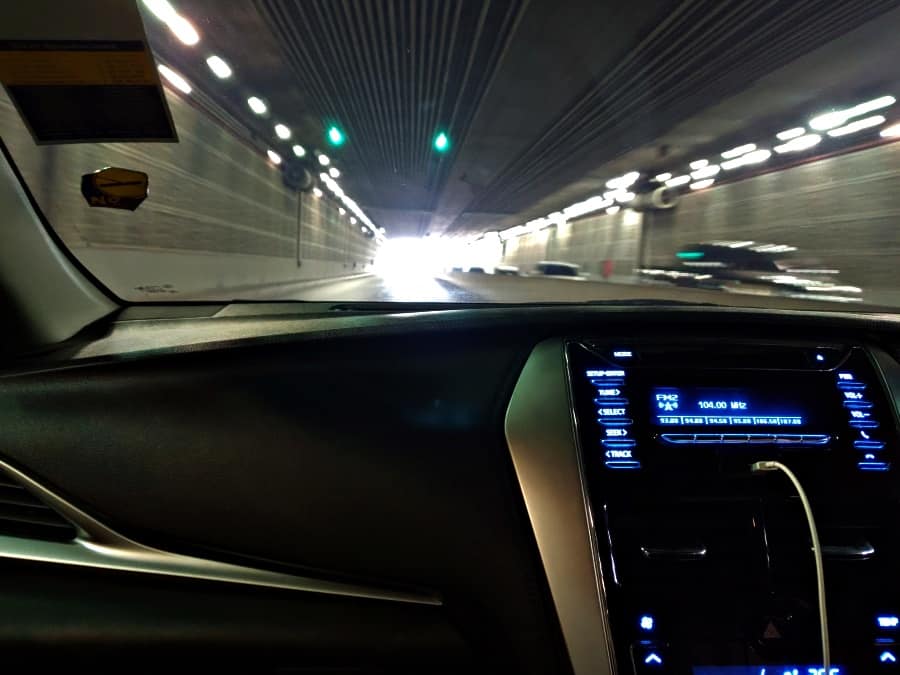
Renting a car is my favorite way to travel medium distances in Thailand. (Bangkok to Hua Hin or to Pattaya for instance).
The reason for me is, I like having the freedom to come and go whenever I want, and my wife and I like to cook and see many places while on vacation. It is just easier to get bags of groceries and a case of drinking water back to our lodging with a car.
That being said, renting a car in Thailand is just like in most countries. Renting on a booking site like Booking.com or the site of your choice, is by far the easiest way. I recommend renting from the airport you are flying in and out of. Also check and take photos of any scratches or damage before you take the car. It is not unusual for a brand new car to have some form of damage.
What do you need (and need to know) to rent a car in Thailand?
You will need a valid driver’s license, your passport and a deposit that is held on your credit card until you return the car.
For more on legal driver’s license requirements in Thailand, read my complete article here.
The number one thing you need to know is that you will be driving on the left side of the road. Therefore, the driver’s seat will be on the right side of the car so you will shift with your left hand and use the turn signal with your right. The only thing that is not changed is the accelerator and brake pedals are the same, (brake pedal is to the left of the accelerator).
How much does it cost to rent a car in Thailand?
Depending on the season and company, a basic compact car should cost around $25 a day. Like anywhere, the bigger and fancier the vehicle, the higher the cost will be. This will include comprehensive insurance, theft protection and third party liability along with whatever promotions they offer.
Check with your credit card company to see if they cover the supplier damage excess amount. If not, you can opt in for the extra coverage with the supplier or you will need that amount open on you credit card in case of an accident.
Options for short distance and city transportation.
Renting a car. Again?
Renting a car also fits in the short distance category quite well. So don’t rule cars out when it comes to getting around the cities and towns. Just remember you will be stuck in traffic with a car more often than with some other forms of short distance transportation.
Rent a Motorbike to Zip Around cities and towns.
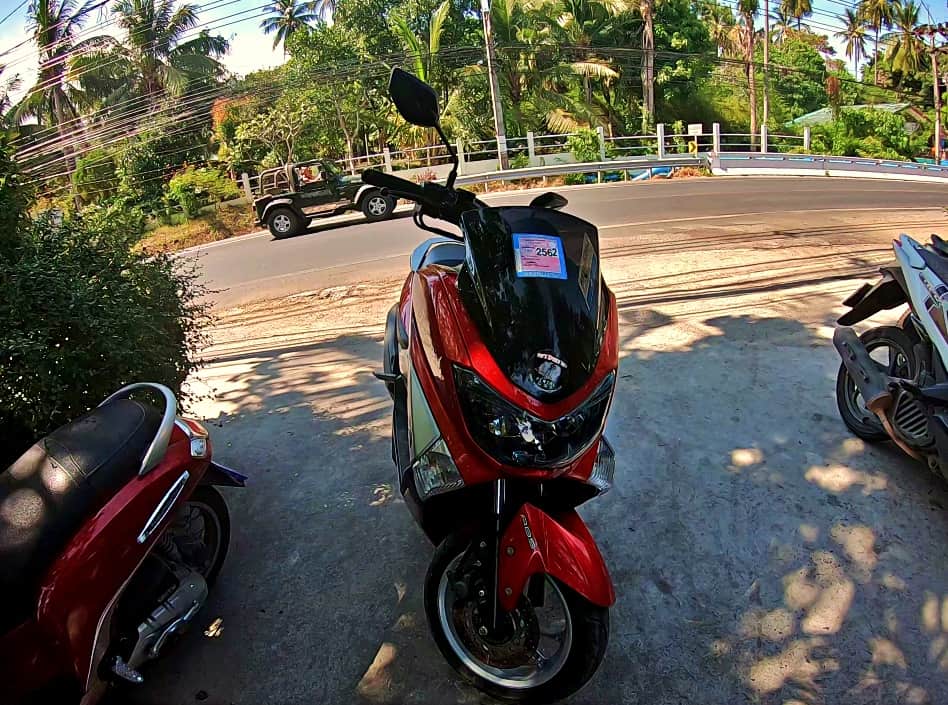
Renting a motorbike is a great option for exploring Thailand’s cities and towns. Although you can go a long distance on a motorbike, it is just not that practical. You can’t bring much more than a backpack and traveling long distances on a motorbike during the rainy season can be a challenge. Therefore I kept this in the short distance category.
What do you need to rent a motorbike?
You will need your passport, some cash and you will fill out a form with your phone number and address where you are staying.
It is not common that rental shops will accept credit cards, so bring cash for your advanced payment and security deposit. The average cost per day starts at 150 THB or $5 and higher up the bigger the bike.
Most companies will ask you to leave your passport as a deposit for the duration of the rental. I do not recommend you do this because it is illegal to be without your passport in Thailand. Your passport is your legal ID.
So, ask the clerk if you can leave a cash deposit (usually between 3000-5000 THB or $100-$165) and a copy of your passport. If they refuse, just go to another company. Don’t worry, there are many to choose from in every village, city, town and island in Thailand.
Do you need a motorcycle driver’s license?
Although most rental companies will not ask to see your motorcycle driver’s license, it is technically illegal to drive a motorbike in Thailand without one. If you get stopped by Thai police, they might just ask to see your passport and or regular driver’s license. Just note that you are taking that risk and more than likely the officer will fine you on the spot and let you drive off again. (Driving illegally).
Do you need insurance?
Although it is not required, I recommend renting from a company that offers insurance. Ask upfront if the insurance covers loss, damage and health if the driver and passenger gets hurt.
Before you rent the bike, ask what the procedure is if you have a claim. Some will require you to pay for damages upfront and claim later. Again, if they have no insurance, or it is pay now claim later, go to another company.
Insurance is probably the most important thing to get right. But, as I said before, if you don’t have a motorcycle license from back home, you are driving illegally in Thailand. If you are using travel insurance and you get in an accident without the proper license, the insurance will not cover you.
Safety!
Wear a helmet and some real shoes! Don’t worry about what others are doing. Just understand that Thailand’s cities are jam packed with vehicles you have probably never seen or been on the road with. If you don’t feel comfortable driving like a Thai, then don’t! Thai drivers know there are tourists like you that can’t drive like them and therefore will work around you.
Because you are a farang (visitor), most accidents will be considered your fault. Even if it wasn’t your fault, don’t fight it, just negotiate it down as much as you can and move on.
Car Taxis.
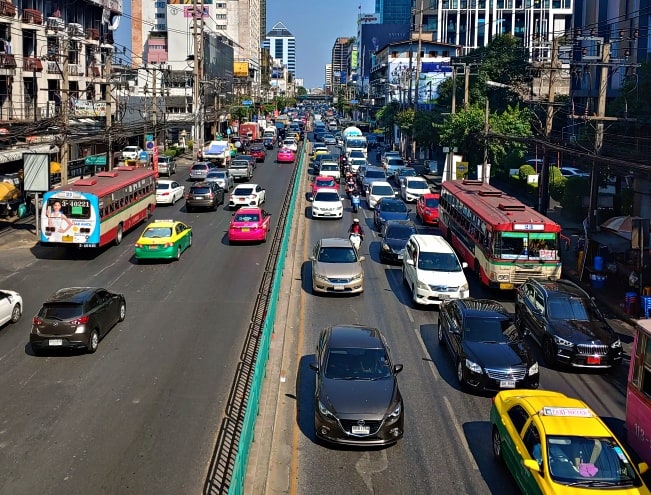
You will find car taxis in just about every city, town and island in Thailand and they are a great way to get around if you know what you are doing. Bigger cities like Bangkok will have them cruising around nearly 24 hours a day.
Taxis are very affordable (metered taxi) with fares starting at around 35 THB or $1.14 until the first 2 kilometers. After that, 2 THB or $.06 per kilometer. Surcharges can be applied in traffic jams of around 1.25 THB or $.04 per meter for 6 km per hour traffic.
Here are some tips to get you going.
1. Taxi colors.
Most of Thailand’s taxis are easy to spot because of their bright colors. Pink, light blue, yellow top with a green bottom, orange, red and of course, yellow are the norm.
2. Flagging a taxi.
You can find taxis just about anywhere and it is okay to flag them down. Just note, make sure the red vacant sign is on. If they don’t stop, just wait for the next one. No worries.
3. Bad taxi drivers.
If you flag a taxi and they refuse to turn on the meter, just politely move on. Some taxi drivers might also refuse to go where you want to go. This is also okay. Just move on until you find one that will.
If a driver insists on taking you to places they say are good, just decline and move on. They are probably being paid a commission by the establishment they want to take you to.
4. Communicating with the driver.
Lots of taxi drivers will know some basic English, but it is a good idea to be prepared. Get your lodgings flyer or business card so you can show the driver. Download a Thai translator app and add the places you will be going and staying. This should be done ahead of time as to not waste the drivers time. After all “time is money”.
5. Taxi fares and tips.
For the most part, taxis are metered. If you are not sure, just ask someone on staff at your hotel or your lodging if taxis are metered in that area or city. In the event that they are not, you will be given a flat rate and it will usually be higher than a metered fare.
You can try to bargain them down (or not). That is up to you if you think it is too high. Me personally I don’t think it is worth the hassle to save what amounts to .25 cents to $2 or even less.
Tipping is pretty simple. I just don’t tip a non-metered taxi driver and I do tip a metered taxi driver. You can tip as much as you want, but generally, rounding the fare up is acceptable. (If the fare is 55 THB just give them THB 60).
These drivers work very long hours behind the wheel in some of the most stressful traffic in the world and for little pay. So tip!
6. Leaving the taxi.
Make sure you get all your belongings. The last thing you want is to leave your cell phone in a taxi. It will be gone forever.
Now that you have checked your belongings, look before you open the door. Especially in bigger cities. Smaller vehicles like motorbikes and tuk tuks and even pedestrians are zooming in and out and around bigger vehicles in traffic. Even on the sidewalk side you might have motorbikes. Just look before you leap!
Motorbike Taxis.
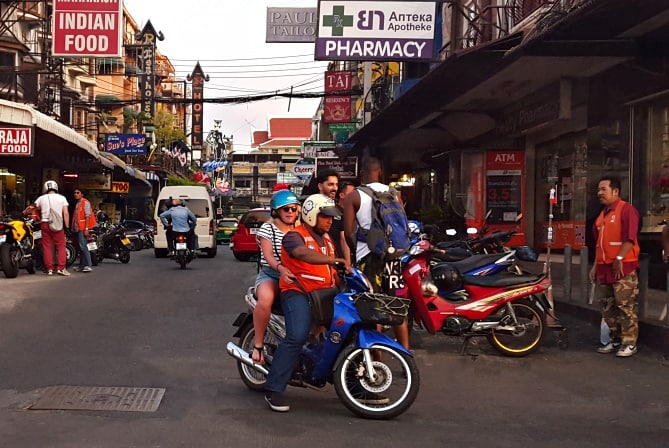
If you want to quickly get around traffic in the bigger cities like Bangkok or Pattaya, jump on a motorcycle taxi or (moto-taxi). This is by far the fastest way to get around, especially in rush hour. Because they will weave through traffic in any way they can, be it through small soi’s (alleys), parking lots and sidewalks to get you to your destination as quickly as possible.
Finding a moto-taxi.
These taxi’s are everywhere in the bigger cities. They will be wearing a bright colored vest in either orange, pink, green or royal purple, with a number and a name tag.
Commonly you will find them in a group at the busiest locations throughout the city like shopping malls, busy soi’s and entrances to public transportation. They can also be flagged down if you see one coming down the street.
Just don’t expect them to stop because they might be out of their assigned workable area. They can drop off in an unassigned area but they can not pick up as that is infringing on another areas fares.
What to do when you find a driver.
Basically like car taxis, they might have limited English, so have your destination in Thai on your translation app or on paper, (ask lodging staff to write it in Thai).
Once they agree, ask for the price. Some will try to rip you off and charge you more because they think you don’t know. Again ask your lodging staff what the normal rates are in that area.
Typically, prices will start at THB 10 or .35 cents and go up in increments of 10 the further you go. So a ride up three long blocks may be 20-30 THB or .70 cents-1.00. Very inexpensive.
For me, tipping is the same as regular taxis. I am just not worried about bargaining over a few cents. I just give another THB 10- 20 depending on the ride and how far.
How to safely ride a moto-taxi.
1. Ask for a Helmet
As I mentioned before, wear a helmet on a moto-bike. Especially if you are going a longer distance through main roads and heavy traffic. Riding down a soi for a few blocks is not necessary. Most taxi’s will have a spare helmet but won’t offer it because they are not fined if you don’t wear it, but you are. So ask for one and they will usually oblige.
2. How to sit and ride safely.
Sit astride on the bike unless you really can’t because of a shorter skirt. Sitting astride is the safest way to ride. Sitting side saddle is not a good idea unless you have lots of experience doing so. Your balance will be off and you have less control in an accident. In most cases, sitting side saddle, you will be thrown off the bike in an accident.
In either case, hold onto the handrail at the back of the seat. Taxi drivers don’t really like you holding on to them around their waist. They need to be free to move as the bike moves and turns in and out of traffic and around objects.
Keep your elbows, knees and feet in. You don’t want a broken bone or gash when you pass a car mirror and your elbow is too far out.
3. Pay attention.
Look ahead and watch what is happening around you. If the driver has to dodge around something, you will see it coming and be able to move or lean accordingly. The driver is good, but not that good if you become a 150 pound weight pulling in the wrong direction the bike needs to go.
4. Don’t get burned.
Last but not least. Get off on the left side of the bike. The exhaust pipe is on the right side and it is scorching hot. If you get off on the right, you will almost always get burned, and it won’t be pretty.
5. Slowing down the moto- taxi.
If you are feeling uncomfortable about the speed, ask the driver to slow down. It is normal for the driver to go as fast as they can because they assume that is why you chose a moto-taxi. Just say “Chaa chaa” and they will usually slow down for you.
Using songthaews.
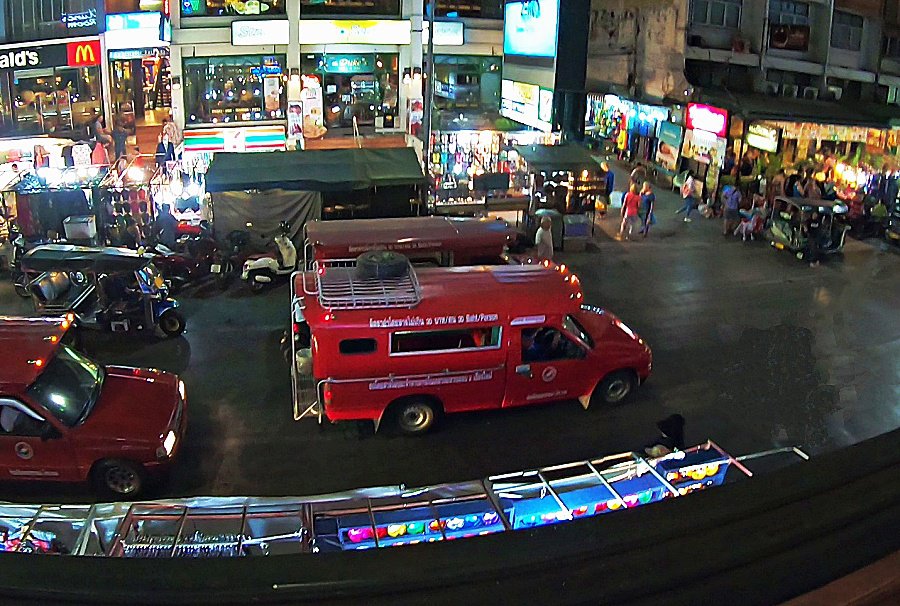
Songthaews (meaning “two rows” in Thai) are covered pickup trucks with two benches in back and they basically work like a bus or a taxi depending on how you hire them.
Although you will find them in most cities and towns in Thailand, they don’t all work the same in each city. For instance, in Chiang Mai you will find them in different colors that represent where they travel. Red for inner city and each of the other colored songthaews will travel to outlying towns.
In Pattaya, they are usually blue and will travel in a set route around town. Just ask someone on staff at your accommodations and they will help you understand the system in your particular area.
Hiring a songthaew.
Unlike a bus but more like a taxi you can flag songthaews down. They will stop just about anywhere they can fit along their route to pick up and drop off. Just stand on the side of the road in the direction you are going and flag one down. If they don’t stop, it is either full or privately hired. Don’t worry, another one will come by in a few minutes.
If you don’t know the route they are on, tell the driver your destination and they will nod yes or no. If yes, hop in back and when you want to get out, ring the bell and when it stops, go to the driver side window and pay for the ride.
How much do they cost?
Usually the price will start at 10 THB or 35 cents and work up in increments of 10 the further you go. And, it is uncommon to exceed 100 THB or $3.40.
If you want to hire a songthaew privately, you need to find one that is parked on the side of the road that is empty. Go to the driver and tell them where you want to go and for how long and they will tell you the price. If you are going where there aren’t any songthaews, book it as a round trip. The driver will wait for you as long as you have the cash.
Tuk Tuks.
Tuk tuks are three wheeled covered motorcycles with a two person bench seat in back. In my opinion, this mode of transportation is more for the experience than anything else. If you want to say you did, than take a short ride and say you did.
Tuk tuks cost more than a metered taxi at around 150 THB or $5.00 for a short ride. They are limited on speed and can’t get through traffic like a moto-taxi. They are also a major contributor to air pollution and if it is raining you will get pretty wet as you are sitting in a traffic jam, breathing in the exhaust of the diesel truck next to you.
Just take a short ride and take some video and pic’s to show back home.
Getting to the islands of Thailand.
Ferries and Boats.
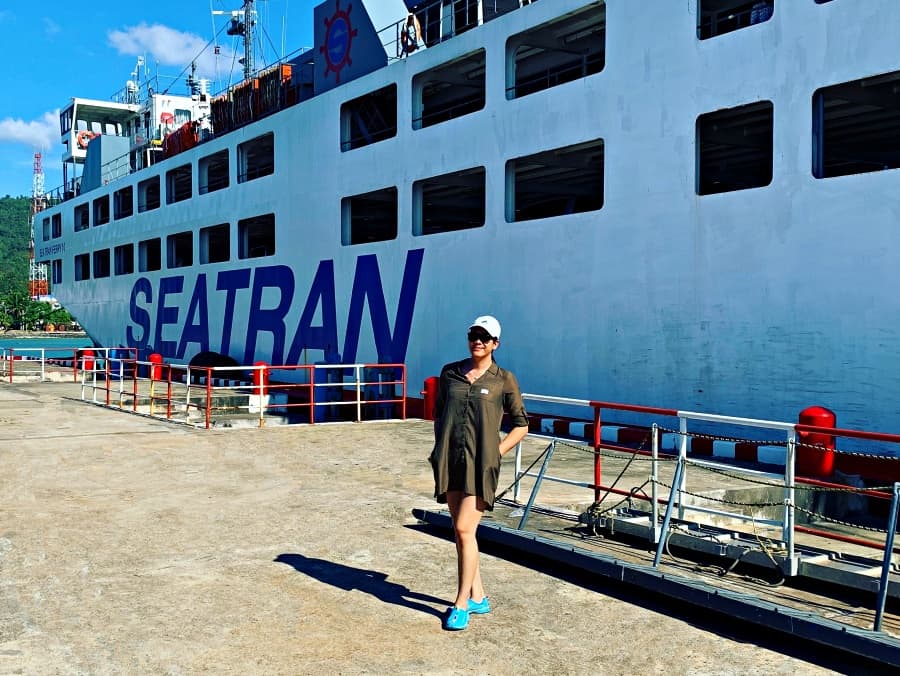
Ferries and long boats are the main mode of transportation to the many islands that Thailand has to offer. Basically, if you want to go to an island, you will take any one of the modes of transport mentioned above to a pier and hop on a ferry to the island.
Where to get tickets?
Well this will all depend on if you need transport to the pier to catch the ferry. If you are already close to the pier, you can buy them there. But if you are far from the pier, you will probably want a combined bus and ferry ticket. 12go.asia is a good place to buy tickets. All the ticket possibilities are on their site.
How much does it cost to take a ferry.
The price will vary depending on the company, type of ferry, class, destination and distance.
A standard class ticket on a Seatran ferry from Donsak pier in Surat Thani to Koh Samui for instance is 150 THB or $5.00 and takes an hour and a half.
Another example is, from Pattaya to Koh Larn it takes 40 minutes and is a whopping 30 THB or .99 cents.
Pattaya to Hua Hin ferry.
The only exception to islands is the ferry from Pattaya to Hua Hin. This ferry takes you across the bay to Hua Hin in 2 hours and back again once a day. This is a convenient way to save a 4 to 6 hour drive (each way) if you want to visit the laid back communities of Hua Hin and the surrounding area. Plan on staying overnight because the ferry leaves Pattaya at 1 pm and comes back from Hua Hin at 4 pm, so the return ticket is the next day (or longer). Round trip tickets are 1,250 THB or $42. Ferry website here.
Public transportation.
This is a pretty limited option for most smaller cities in Thailand so I will just mention a few things.
Bangkok.
Bangkok is the largest city in Thailand and has the most public transport options. Public buses, the sky train (BTS), subway (MRT), the airport rail link and public boats are the most used here.
Public buses are mainly used by Thai locals and cost 6 THB or .20 cents.
The airport rail link runs from Suvarnabhumi Airport all the way to downtown Bangkok, linking to the MRT and BTS. The rail link is in the basement of the airport.
The sky train (BTS) and subway (MRT) are linked as well and can get you around most of Bangkok city. Here is a link to Bangkokbts.com to help you with time tables, stations, route maps, fares and tickets.
Public boats in Bangkok.
Yes, you read that right. There are several boats and waterways that are linked to other public transportation in Bangkok.
1. River crossing ferries are flat boats that cross at 32 different piers bringing people from one side of the Chao Phraya river to the other for 3 THB or .10 cents.
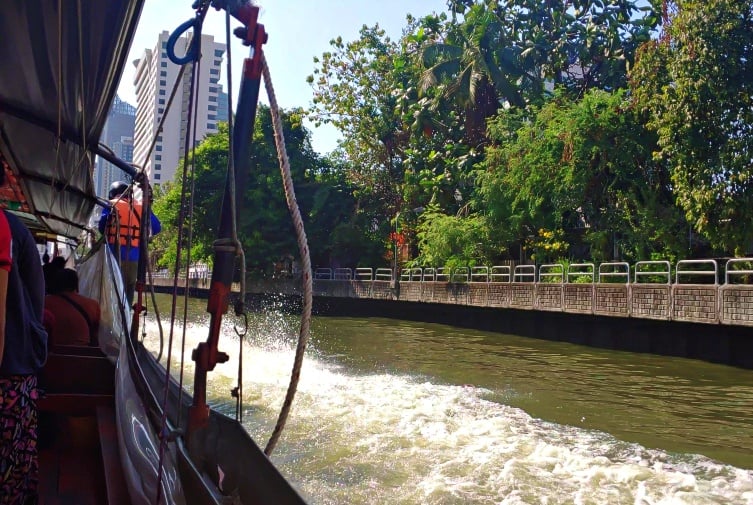
2. Canal boats will be found going up and down large canals in Bangkok. These taxi’s cost 9 and 19 THB or .30-.65 cents depending on distance. They are very busy during rush hours because local office workers use these to commute from eastern suburbs.
3. Hotel shuttle boats are dedicated to five star hotels and are free of charge. They shuttle guests from hotels to Sathorn Central Pier that connects to the BTS Skytrain.
4. Orange flag boats are public service boats that go up and down the Chao Phraya River every 15 minutes and cost 15 THB or .50 cents no matter the distance. These boats stop at all the relevant tourist areas.
Other cities.
If there is any public city transportation in all other cities it will be public buses.
Conclusion.
One of the main things to make getting around Thailand less stressful is to slow down a bit and understand that you will be learning new things as you go. Don’t worry if you go the wrong way on your motorbike or get on the wrong songthaew, it is all correctable and quite normal for newbies.
Happy getting around Thailand!
